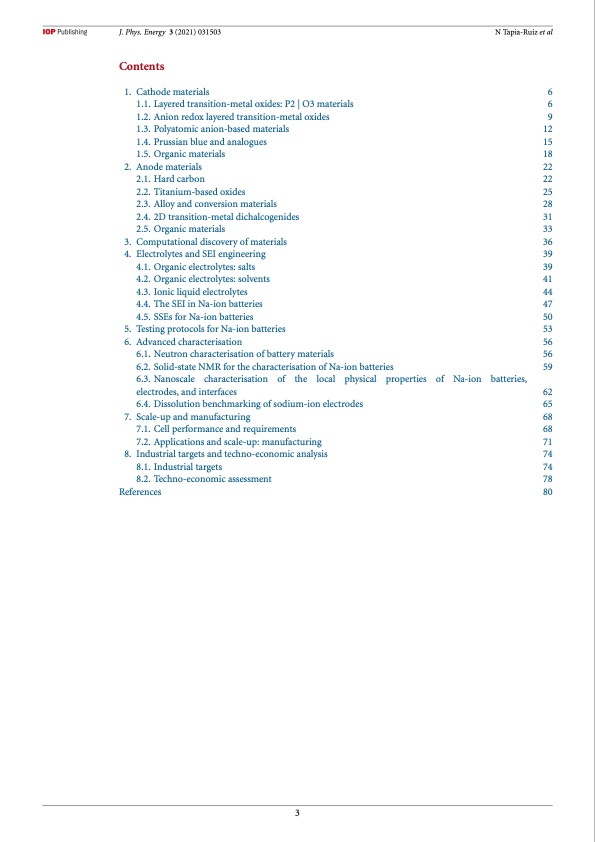
PDF Publication Title:
Text from PDF Page: 004
J. Phys. Energy 3 (2021) 031503 N Tapia-Ruiz et al Contents 1. Cathode materials 1.1. Layered transition-metal oxides: P2 | O3 materials 1.2. Anion redox layered transition-metal oxides 1.3. Polyatomic anion-based materials 1.4. Prussian blue and analogues 1.5. Organic materials 2. Anode materials 2.1. Hard carbon 2.2. Titanium-based oxides 2.3. Alloy and conversion materials 2.4. 2D transition-metal dichalcogenides 2.5. Organic materials 3. Computational discovery of materials 4. Electrolytes and SEI engineering 4.1. Organic electrolytes: salts 4.2. Organic electrolytes: solvents 4.3. Ionic liquid electrolytes 4.4. The SEI in Na-ion batteries 4.5. SSEs for Na-ion batteries 5. Testing protocols for Na-ion batteries 6. Advanced characterisation 6 6 9 12 15 18 22 22 25 28 31 33 36 39 39 41 44 47 50 53 56 56 59 7. Scale-up and manufacturing 68 7.1. Cell performance and requirements 68 7.2. Applications and scale-up: manufacturing 71 8. Industrial targets and techno-economic analysis 74 6.1. Neutron characterisation of battery materials 6.2. Solid-state NMR for the characterisation of Na-ion batteries 6.3.Nanoscale characterisation of the local physical properties of Na-ion batteries, electrodes, and interfaces 62 6.4. Dissolution benchmarking of sodium-ion electrodes 65 8.1. Industrial targets 8.2. Techno-economic assessment References 74 78 80 3PDF Image | roadmap for sodium-ion batteries

PDF Search Title:
roadmap for sodium-ion batteriesOriginal File Name Searched:
sodium-ion-batteries.pdfDIY PDF Search: Google It | Yahoo | Bing
Product and Development Focus for Salgenx
Redox Flow Battery Technology: With the advent of the new USA tax credits for producing and selling batteries ($35/kW) we are focussing on a simple flow battery using shipping containers as the modular electrolyte storage units with tax credits up to $140,000 per system. Our main focus is on the salt battery. This battery can be used for both thermal and electrical storage applications. We call it the Cogeneration Battery or Cogen Battery. One project is converting salt (brine) based water conditioners to simultaneously produce power. In addition, there are many opportunities to extract Lithium from brine (salt lakes, groundwater, and producer water).Salt water or brine are huge sources for lithium. Most of the worlds lithium is acquired from a brine source. It's even in seawater in a low concentration. Brine is also a byproduct of huge powerplants, which can now use that as an electrolyte and a huge flow battery (which allows storage at the source).We welcome any business and equipment inquiries, as well as licensing our flow battery manufacturing.| CONTACT TEL: 608-238-6001 Email: greg@salgenx.com | RSS | AMP |